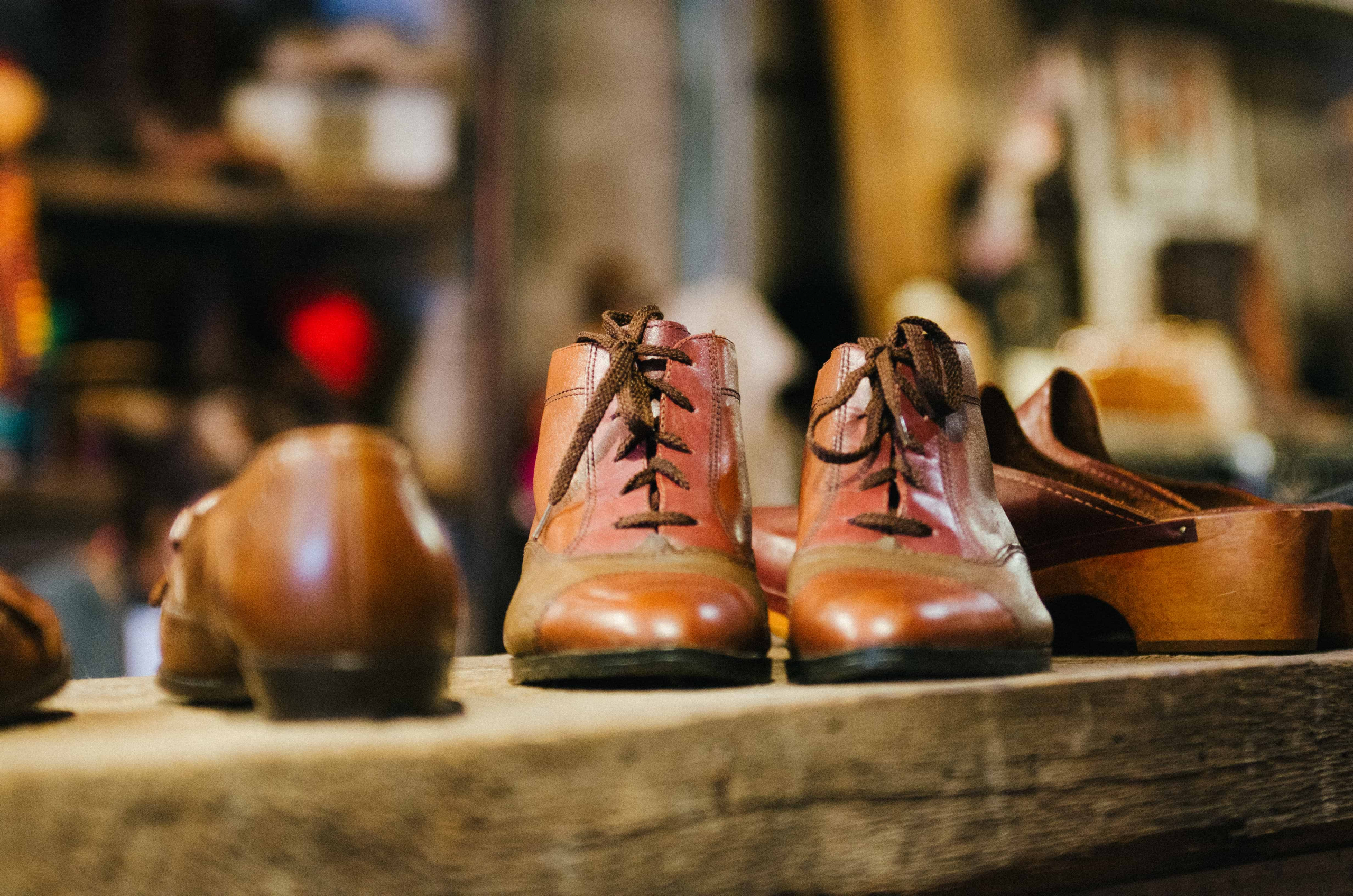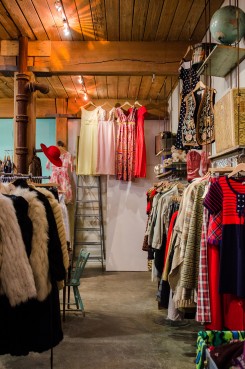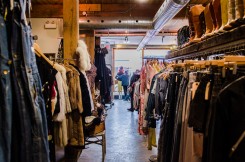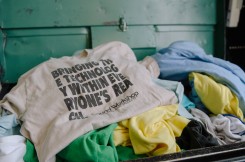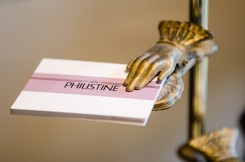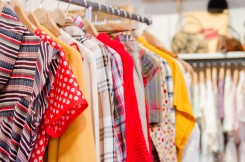A trendy polyester dress sits on a hanger right in front of a dozen dresses in the exact same style. You take an immediate liking to it, because it looks like something you saw on the runway. Only this will cost you a mere $24.99, rather than $2,499. Paris is the inspiration, but the tag says it’s made in Indonesia. Without even thinking about it, you push aside the dresses and pick out your size. There’s no need to try it on — this is your fifteenth or so time shopping here. You hastily walk over to the checkout before the line gets too long. In front of you, another shopper is clutching the exact same dress. She’s probably only buying it because her best friend wore it a few nights ago. This is fast fashion, and it is what it is: simple, cheap, and disposable.
Vintage fashion is nothing like fast fashion.
[pullquote]While Toronto might not be particularly fashion forward in comparison to the major players like New York, London, Milan, and Paris, many consider it one of the best places to acquire vintage clothing.[/pullquote]
There is a unique, even thrilling, experience associated with vintage fashion that you simply can’t achieve with fast fashion. Each piece of clothing hanging on the racks in a vintage store is there for a reason. It’s a labour of love, a result of a vintage picker’s hard work searching for the perfect 1920s beaded gown. Vintage clothing has origins that are much more complicated — and often mysterious — than one could possibly imagine.
In Toronto, there are over 30 stores dedicated to vintage clothing and accessories. Thirty is just a rough estimate, with new spots frequently opening and many multipurpose shops incorporating vintage clothing into their stock. Many associate Toronto vintage with Kensington Market, but it doesn’t stop there. Most of Toronto’s vintage community exists outside Kensington Market’s boundaries, in neighbourhoods located in Toronto’s west and east end, where rent is cheap and large spaces are still available.
I.
It can be difficult to define vintage, as the term is often used to describe a certain movement or aesthetic. For a piece of clothing to be termed “vintage” it must be made before the 1990s. However, the fashion community has recently placed ’90s grunge under the very broad umbrella of vintage. Most importantly, vintage clothing speaks to quality. There is a reason why a 1950s cocktail dress costs $150. It’s because it has over 50 years of life. Back then, clothes were made with quality — not quantity— in mind.
Charlie Irani of Queen Street West boutique 69 Vintage is quick to point out that people often assume vintage is just a synonym for secondhand and thrift shop clothing. This is just one of the many misconceptions that can cause hesitation towards making the leap over to purchasing vintage. While some thrift store purchases can be vintage, vintage clothing is not thrift per se.
II.
Vintage store are diverse in their own right. One store might specialize in fancy prom and party dresses, whereas another might sell Canadiana-inspired work wear. In contrast, Value Village tends to group different types of clothes together. A $6.99 silk blouse at Value Village will most likely be stuffed right next to a row of identical generic brand collared shirts, all going for $1.99 apiece. With vintage clothing stores, a lot of behind-the-scenes curation that goes on before the clothes make it onto the selling floor.
A combination of media promotion and the accessibility offered by e-commerce websites like Etsy and eBay has led to vintage being considered a trend of its own. Now, it’s a common sight for magazines to boldly declare ‘vintage Levi’s cutoffs’ as a must-have item for the next season. Contemporary fashion designers tend to delve into the past as points of inspiration for upcoming collections. For instance, it was clear that the oversized flannels and little slip dresses of Hedi Slimane’s fall collection for Saint Laurent Paris were heavily influenced by 1990s California grunge.
III.
While Toronto might not be particularly fashion forward in comparison to major players like New York, London, Milan, and Paris, many consider it one of the best places to acquire vintage clothing. Irani says that Torontonians “know how to respect and take care of their clothes,” a sentiment echoed by Colleen Ramage, co-owner of Parkdale store Philistine.
The vintage clothing supply chain is nothing like the fast fashion supply chain. For fast fashion companies, clothes go through various levels of production before ending up in the customer’s hands. This process is both environmentally exhaustive and expensive — which is why some stores make you pay nearly $50 for something as simple as a white t-shirt. It’s more difficult to map out the exact origins of vintage clothing.
Throughout the Greater Toronto Area, there are a number of so-called rag houses located in unassuming industrial neighbourhoods. According to Ramage, these rag houses are independent companies what specialize in “importing clothes from Central America, Europe, and Africa,” regions where the demand for vintage fashion isn’t as intense as here in Toronto.
These clothes arrive at the unmarked warehouses by the truck-full. The few buyers and pickers who have access to these rag houses are then tasked with sifting through mountains of clothing. Not every piece is vintage. Even if a piece is vintage, one must look for serious damage and other signs of wear and tear. Buyers and pickers are well versed in separating valuable vintage from clothes that are simply used. You can spend hours sorting through tons of clothing, only to leave the rag house with a small bag full of men’s sweaters.
The exact locations of these rag houses from which stores like Philistine and 69 Vintage pick clothes remain a highly-guarded secret. Irani, who has been working at 69 Vintage for almost a year and has quite the keen eye for vintage, explains that Kealan Sullivan, the store’s owner, is the sole picker and buyer for both 69 Vintage and its high-end counterpart, V by 69 Vintage. Due to the super competitive nature of vintage clothing and the declining supply of ‘good’ vintage, the last thing any vintage buyer wants to do is reveal their sources.
Jessica, who asked to be identified under a pseudonym, is a picker for an established vintage store in Europe, and is one of the few people in Toronto who has access to these warehouses on a daily basis. On a typical day, she can pick anywhere from 100 to 150 pounds of clothing. Before the clothes are shipped back to Europe, they must be sorted into varying groups based on style and quality.
Just a week ago, Jessica returned from a trip to Houston, where she spent a week picking for the store. Despite the change of environment, she claims, “no matter where you go, you see the same kind of product. Except, in Toronto, there is a lot more Blue Jays merchandise.” This is a clear indicator that special vintage finds are becoming more rare as vintage fashion enters the mainstream. In an effort to stay ahead of the pack, Jessica’s store has started to source some of their clothing from countries such as Nicaragua and India.
69 Vintage doesn’t really scour the globe in search for quality vintage; however, Irani tells me that “[Kealan] does go to America for the Levi’s and the ‘really special’ Americana pieces that are difficult to get here in Canada.” For 69 Vintage, the supposedly declining supply of vintage hasn’t set off any alarm bells yet. As of right now, Toronto’s (and America’s) vintage is serving them just fine.
IV.
It’s clear that rag houses are vital in the used clothing supply circuit, but they’re not the only way of acquiring vintage. Many believe a vintage clothing store is simply a platform for good thrift shoppers to sell their Value Village finds, but one cannot expect to run a sustainable business on thrift finds alone. Ramage does venture over to the local thrift shop every once in a while, but she deems the searches there to be a little bit “unfruitful.” Time is money, and having to go to Value Village with hopes of finding profitable vintage is a task that requires too much effort for a small gain. Similarly, Ramage also takes trips out to smaller communities where estate sales, sweater drives, and flea markets are common occurrences — but, like thrifting, it’s not a sustainable business practice.
V.
To the outsider looking in, vintage clothing can be indistinguishable from things you might buy at H&M and Urban Outfitters. It’s hard not to take the easy way out by purchasing ‘vintage-inspired’ garments from clothing retailers. But fast fashion doesn’t come with the history that’s associated with vintage clothing. You can’t go into an H&M and ask the sales associate about the history of the pile of graphic t-shirts folded neatly on the table, because chances are, there is no history.

